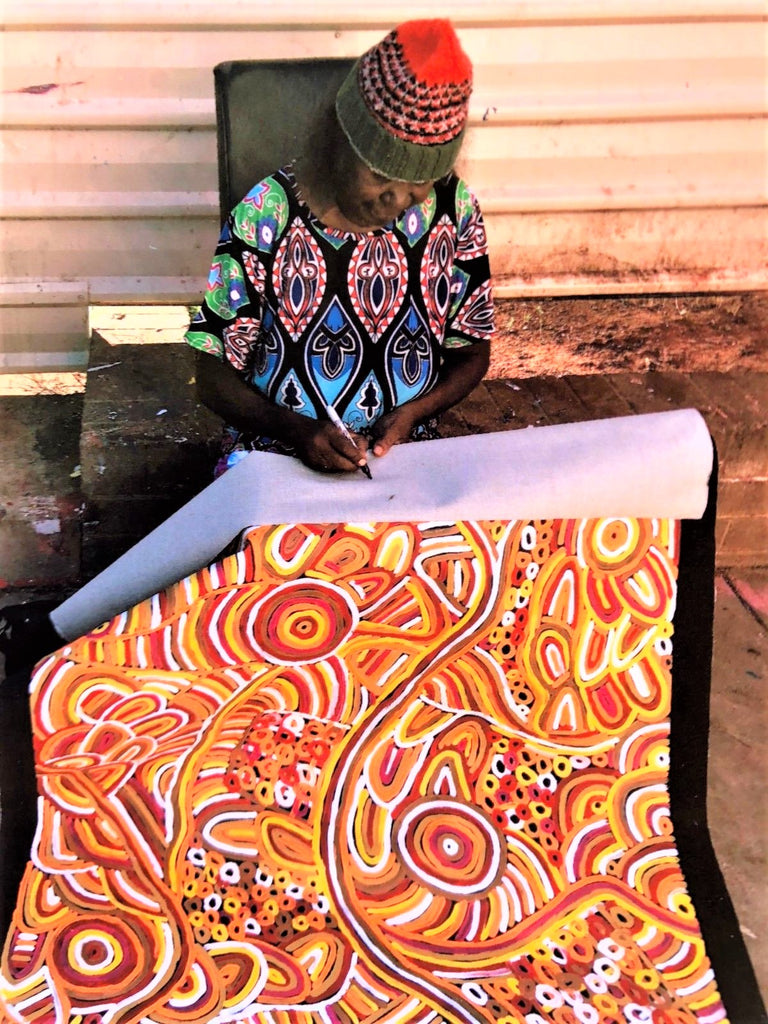News / Betty Mbitjana
Indigenous Art or Aboriginal Art?
The words ‘Aboriginal’ and ‘Indigenous’ are both used in Australia to describe the original inhabitants of the Australian continent. The word ‘Aboriginal’ is the established way to describe the first inhabitants, regularly used in contexts of Aboriginal community, Aboriginal health, Aboriginal art etc. ‘Aboriginal’ is also used as a noun, so a person is an Aboriginal as well as an Aborigine, which seems to be used less often in the media.
As the term ‘Aboriginal’ is the established way to describe first inhabitants in Australia, we then extend that to ‘Aboriginal and Torres Strait Islanders’ to cover all first inhabitants on Australia and its northern islands. Maybe the use of ‘Indigenous’ has come into use as a term to cover all these groups, and ‘Indigenous Art’ has perhaps come into use with it. It is certainly a term that we associate with use in North America, where we hear of the first inhabitants of Canada and USA described as ‘Indigenous Nations’.
But it seems that there are political aspects to the use of the word ‘Indigenous’ in Australia, as governments have incorporated the word into government department names and into policies. Zoltan Kovacs writes on language use in his Opinions column in the West Australian. In his article ‘In the beginning there were…Aboriginals’ in the West Australian on 25-26 January 2014, Zoltan Kovacs writes –
“The word ‘Indigenous’- written with a capital first letter and used as a substitute for ‘Aboriginal’ – has gained mysterious prominence in everyday language over the past 10 years or so. It is hard to see what benefit people who prefer it to Aboriginal find in its use.
Indeed it has the disadvantage of being essentially an adjective, though the Macquarie Dictionary surprisingly lists its use as a noun with the definition of ‘an Aboriginal or Torres Strait Islander’. It seems impossible to use it as a noun without doing violence to the language… Further ‘Indigenous’ has no plural, which is a severe impediment to its use as a noun.
On the other hand, the use of ‘Aboriginal’ as both adjective and noun and in the singular and plural forms has been well established for generations. Of course if there were evidence of a preference by Aboriginal communities for the use of Indigenous, then that should be a powerful argument in its favour. The evidence is to the contrary.
The State Government changed the name of the Department of Indigenous Affairs to the Department of Aboriginal Affairs last year as a result of what it said were the requests of the WA Aboriginal community and consultations with Aboriginal people. The change was made without evident dissent.
A WA Aboriginal leader of accomplishment, Robert Isaacs, has taken the matter further by telling Prime Minister Tony Abbott that many Aboriginal and Torres Strait Islander people object to the collective description of them as Indigenous. He wrote to Mr Abbott that he, ”as an Aboriginal person and Noongar Elder”, supported their objection to the term, which was increasingly used by government agencies. He argued, in essence, that the term robbed Aboriginal people of their identity.
A reasonable conclusion to be drawn from his letter is that Aboriginal communities are entitled to a sense of grievance if the decision to identify them officially as Indigenous was made without their views being sought and considered. Further it is undeniable that Indigenous is a neutral, bland word without traditional associations…it fails to capture and reflect the unique standing of an ancient people who were the first occupants and custodians of this land.
The word Aboriginal symbolically conveys this history and tradition and can be used respectfully. It is a name by which descendants of the first people of this country are known worldwide. After all, it is made up mostly of the word original.”
In a nutshell, the term ‘Aboriginal’ is so closely associated with Australian first inhabitants that it will remain the principal descriptor for all things associated with Australian Aborigines.

